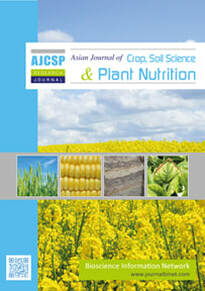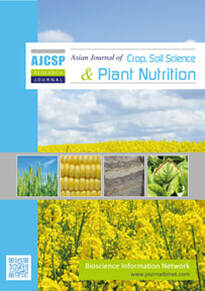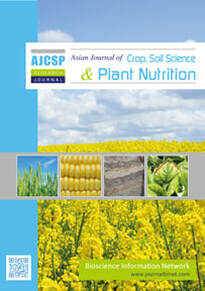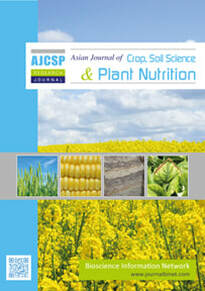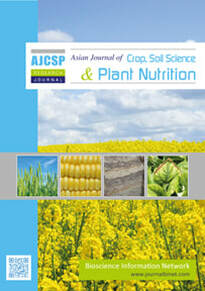Asian Journal of Crop, Soil Science and Plant Nutrition
Volume 05 - Issue 01 | Year of Publication: 2021
Article Type: Research Article | No. 21, 2020 | Country: Bangladesh | pp. 165-169 | Open Access
Title: Evaluation of organic fertilizer on cabbage production at Mymensingh and Jamalpur, Bangladesh
Authors: Tasmin, S., Khan, M. R., Tarafder, M. M. A., Hasan, A. K. and Rahman, M. H.
DOI: https://doi.org/10.18801/ajcsp.050121.21
Title: Evaluation of organic fertilizer on cabbage production at Mymensingh and Jamalpur, Bangladesh
Authors: Tasmin, S., Khan, M. R., Tarafder, M. M. A., Hasan, A. K. and Rahman, M. H.
DOI: https://doi.org/10.18801/ajcsp.050121.21
Evaluation of organic fertilizer on cabbage production at Mymensingh and Jamalpur, Bangladesh
Abstract
Organic fertilizer (OF) has positive effects on soil, especially soil fertility and productivity. Two experiments were conducted at the farmer’s field of Mymensingh and Jamalpur to observe the effect of organic fertilizer on cabbage production during rabi season 2018. There were seven fertilizer treatments viz: T1: RCF (N150 P40 K100 S16 Kg ha-1), T2: 85% RCF, T3: 70% RCF, T4: 85% RCF + 3 t ha-1 OF, T5: 85% RCF + 1 t ha-1 OF, T6: 70% RCF + 3 t ha-1 OF and T7: 70% RCF + 1 t ha-1 OF. The experiments were laid out in a RCBD (Randomized Complete Block Design) with three replications. The average fresh yield at Mymensingh ranged from 34.5 to 60.0 t ha-1 with the highest yield of 60.0 t ha-1 from treatment T4 (85% RCF + 3 t ha-1 OF). At Jamalpur, the average yield ranged from 31.5 to 56.3 t ha-1 and the highest yield of 56.3 t ha-1 was recorded from treatment T4 (85% RCF + 3 t ha-1 OF). The lowest yield was found from treatment T3 in both locations. The percent fresh yield increased over control (T1), was 42.85 and 40.04 in Mymensingh and Jamalpur, respectively. The highest gross margin is Tk. 534507, which was obtained from treatment T4 (85% RCF + 3 t ha-1 organic fertilizer). The highest MBCR 3.05 (average of two locations) was obtained from the same treatment T4 (85% RCF + 1 t ha-1 organic fertilizer). The result indicated that applying organic fertilizer and 85% recommended dose of chemical fertilizer is more profitable than applying chemical fertilizers only.
Key Words: Organic fertilizer, Cabbage and Higher yield
Abstract
Organic fertilizer (OF) has positive effects on soil, especially soil fertility and productivity. Two experiments were conducted at the farmer’s field of Mymensingh and Jamalpur to observe the effect of organic fertilizer on cabbage production during rabi season 2018. There were seven fertilizer treatments viz: T1: RCF (N150 P40 K100 S16 Kg ha-1), T2: 85% RCF, T3: 70% RCF, T4: 85% RCF + 3 t ha-1 OF, T5: 85% RCF + 1 t ha-1 OF, T6: 70% RCF + 3 t ha-1 OF and T7: 70% RCF + 1 t ha-1 OF. The experiments were laid out in a RCBD (Randomized Complete Block Design) with three replications. The average fresh yield at Mymensingh ranged from 34.5 to 60.0 t ha-1 with the highest yield of 60.0 t ha-1 from treatment T4 (85% RCF + 3 t ha-1 OF). At Jamalpur, the average yield ranged from 31.5 to 56.3 t ha-1 and the highest yield of 56.3 t ha-1 was recorded from treatment T4 (85% RCF + 3 t ha-1 OF). The lowest yield was found from treatment T3 in both locations. The percent fresh yield increased over control (T1), was 42.85 and 40.04 in Mymensingh and Jamalpur, respectively. The highest gross margin is Tk. 534507, which was obtained from treatment T4 (85% RCF + 3 t ha-1 organic fertilizer). The highest MBCR 3.05 (average of two locations) was obtained from the same treatment T4 (85% RCF + 1 t ha-1 organic fertilizer). The result indicated that applying organic fertilizer and 85% recommended dose of chemical fertilizer is more profitable than applying chemical fertilizers only.
Key Words: Organic fertilizer, Cabbage and Higher yield
HOW TO CITE THIS ARTICLE?
MLA
Tasmin, S. et al. “Evaluation of organic fertilizer on Cabbage production at Mymensingh and Jamalpur, Bangladesh”. Asian Journal of Crop, Soil Science and Plant Nutrition, 05(01), (2021): 165-169.
APA
Tasmin, S., Khan, M. R., Tarafder, M. M. A., Hasan, A. K. and Rahman, M. H. (2021). Evaluation of organic fertilizer on Cabbage production at Mymensingh and Jamalpur, Bangladesh. Asian Journal of Crop, Soil Science and Plant Nutrition, 05(01), 165-169.
Chicago
Tasmin S., Khan, M. R., Tarafder, M. M. A., Hasan, A. K. and Rahman, M. H. “Evaluation of organic fertilizer on Cabbage production at Mymensingh and Jamalpur, Bangladesh”. Asian Journal of Crop, Soil Science and Plant Nutrition, 05(01), (2021): 165-169.
Harvard
Tasmin, S., Khan, M. R., Tarafder, M. M. A., Hasan, A. K. and Rahman, M. H. 2020. Evaluation of organic fertilizer on Cabbage production at Mymensingh and Jamalpur, Bangladesh. Asian Journal of Crop, Soil Science and Plant Nutrition, 05(01), pp. 165-169.
Vancouver
Tasmin S, Khan MR, Tarafder MMA, Hasan AK and Rahman MH. Evaluation of organic fertilizer on Cabbage production at Mymensingh and Jamalpur, Bangladesh. Asian Journal of Crop, Soil Science and Plant Nutrition, 2021 January 05(01), 165-169.
MLA
Tasmin, S. et al. “Evaluation of organic fertilizer on Cabbage production at Mymensingh and Jamalpur, Bangladesh”. Asian Journal of Crop, Soil Science and Plant Nutrition, 05(01), (2021): 165-169.
APA
Tasmin, S., Khan, M. R., Tarafder, M. M. A., Hasan, A. K. and Rahman, M. H. (2021). Evaluation of organic fertilizer on Cabbage production at Mymensingh and Jamalpur, Bangladesh. Asian Journal of Crop, Soil Science and Plant Nutrition, 05(01), 165-169.
Chicago
Tasmin S., Khan, M. R., Tarafder, M. M. A., Hasan, A. K. and Rahman, M. H. “Evaluation of organic fertilizer on Cabbage production at Mymensingh and Jamalpur, Bangladesh”. Asian Journal of Crop, Soil Science and Plant Nutrition, 05(01), (2021): 165-169.
Harvard
Tasmin, S., Khan, M. R., Tarafder, M. M. A., Hasan, A. K. and Rahman, M. H. 2020. Evaluation of organic fertilizer on Cabbage production at Mymensingh and Jamalpur, Bangladesh. Asian Journal of Crop, Soil Science and Plant Nutrition, 05(01), pp. 165-169.
Vancouver
Tasmin S, Khan MR, Tarafder MMA, Hasan AK and Rahman MH. Evaluation of organic fertilizer on Cabbage production at Mymensingh and Jamalpur, Bangladesh. Asian Journal of Crop, Soil Science and Plant Nutrition, 2021 January 05(01), 165-169.
Article Type: Research Article | No. 22, 2021 | Country: Nepal | pp. 170-186 | Open Access
Title: Effect of plant population on performance of maize hybrids under different sowing dates in western terai of Nepal
Authors: Acharya, N. R., Sah, S. K., Gautam, A. K. and Regmi, A. P.
DOI: https://doi.org/10.18801/ajcsp.050121.22
Title: Effect of plant population on performance of maize hybrids under different sowing dates in western terai of Nepal
Authors: Acharya, N. R., Sah, S. K., Gautam, A. K. and Regmi, A. P.
DOI: https://doi.org/10.18801/ajcsp.050121.22
Effect of plant population on performance of maize hybrids under different sowing dates in western terai of Nepal
Abstract
This study was conducted on farmer’s field of Khajura, Banke, during 2014 -2015 to identify the effect of plant population on maize hybrids under different sowing dates in winter season. Soil is sandy loam and humid subtropical climate. Temperature ranges between 460C and 5.40C, with relative humidity ranging between 27 to 94%. Humidity remains low in most parts of the year. Delayed onset and early termination of monsoon rain is a regular feature, causing occasional failure of annual crops in the region. The experiment was replicated three times in stripe –split plot design. Three dates of sowing (20 October, 5 November and 20 November), four hybrids (Rampur hybrid 2, Rampur hybrid 4, Rajkumar and Nutan (KH 101) and three plant densities (83333 plants ha-1, 66666 plants ha-1and 55555 plants ha-1) were used in the study. The average grain yield of maize on 20 October (7.8 Mt ha-1) produced 25.8% higher than 5 November (6.2 Mt ha-1) and 30% higher than 20 November (6 Mt ha-1). Rampur hybrid 2 produced 20% higher average grain yield (7.2 Mt ha-1) than Nutan (KH 101) variety (6 Mt ha-1). Plant population 83333 plants ha-1 (6.9 Mt ha-1) and 66666 plants ha-1 (6.8 Mt ha-1) produced higher grain yield than (6.4 Mt ha-1) at 55555 plants ha-1.
Key Words: Date of sowing, Plant population, Hybrids, Maize and Grain yield
Abstract
This study was conducted on farmer’s field of Khajura, Banke, during 2014 -2015 to identify the effect of plant population on maize hybrids under different sowing dates in winter season. Soil is sandy loam and humid subtropical climate. Temperature ranges between 460C and 5.40C, with relative humidity ranging between 27 to 94%. Humidity remains low in most parts of the year. Delayed onset and early termination of monsoon rain is a regular feature, causing occasional failure of annual crops in the region. The experiment was replicated three times in stripe –split plot design. Three dates of sowing (20 October, 5 November and 20 November), four hybrids (Rampur hybrid 2, Rampur hybrid 4, Rajkumar and Nutan (KH 101) and three plant densities (83333 plants ha-1, 66666 plants ha-1and 55555 plants ha-1) were used in the study. The average grain yield of maize on 20 October (7.8 Mt ha-1) produced 25.8% higher than 5 November (6.2 Mt ha-1) and 30% higher than 20 November (6 Mt ha-1). Rampur hybrid 2 produced 20% higher average grain yield (7.2 Mt ha-1) than Nutan (KH 101) variety (6 Mt ha-1). Plant population 83333 plants ha-1 (6.9 Mt ha-1) and 66666 plants ha-1 (6.8 Mt ha-1) produced higher grain yield than (6.4 Mt ha-1) at 55555 plants ha-1.
Key Words: Date of sowing, Plant population, Hybrids, Maize and Grain yield
HOW TO CITE THIS ARTICLE?
MLA
Acharya, N. R. et al. “Effect of plant population on performance of maize hybrids under different sowing dates in western terai of Nepal”. Asian Journal of Crop, Soil Science and Plant Nutrition, 05(01), (2021): 170-186.
APA
Acharya, N. R., Sah, S. K., Gautam, A. K. and Regmi, A. P. (2021). Effect of plant population on performance of maize hybrids under different sowing dates in western terai of Nepal. Asian Journal of Crop, Soil Science and Plant Nutrition, 05(01), 170-186.
Chicago
Acharya, N. R., Sah, S. K., Gautam, A. K. and Regmi, A. P. “Effect of plant population on performance of maize hybrids under different sowing dates in western terai of Nepal”. Asian Journal of Crop, Soil Science and Plant Nutrition, 05(01), (2021): 170-186.
Harvard
Acharya, N. R., Sah, S. K., Gautam, A. K. and Regmi, A. P. 2020. Effect of plant population on performance of maize hybrids under different sowing dates in western terai of Nepal. Asian Journal of Crop, Soil Science and Plant Nutrition, 05(01), pp. 170-186.
Vancouver
Acharya, NR, Sah, SK, Gautam, AK and Regmi, AP. Effect of plant population on performance of maize hybrids under different sowing dates in western terai of Nepal. Asian Journal of Crop, Soil Science and Plant Nutrition, April 2021 05(01), 170-186.
MLA
Acharya, N. R. et al. “Effect of plant population on performance of maize hybrids under different sowing dates in western terai of Nepal”. Asian Journal of Crop, Soil Science and Plant Nutrition, 05(01), (2021): 170-186.
APA
Acharya, N. R., Sah, S. K., Gautam, A. K. and Regmi, A. P. (2021). Effect of plant population on performance of maize hybrids under different sowing dates in western terai of Nepal. Asian Journal of Crop, Soil Science and Plant Nutrition, 05(01), 170-186.
Chicago
Acharya, N. R., Sah, S. K., Gautam, A. K. and Regmi, A. P. “Effect of plant population on performance of maize hybrids under different sowing dates in western terai of Nepal”. Asian Journal of Crop, Soil Science and Plant Nutrition, 05(01), (2021): 170-186.
Harvard
Acharya, N. R., Sah, S. K., Gautam, A. K. and Regmi, A. P. 2020. Effect of plant population on performance of maize hybrids under different sowing dates in western terai of Nepal. Asian Journal of Crop, Soil Science and Plant Nutrition, 05(01), pp. 170-186.
Vancouver
Acharya, NR, Sah, SK, Gautam, AK and Regmi, AP. Effect of plant population on performance of maize hybrids under different sowing dates in western terai of Nepal. Asian Journal of Crop, Soil Science and Plant Nutrition, April 2021 05(01), 170-186.
Article Type: Research Article | No. 23, 2021 | Country: Bangladesh | pp. 187-192 | Open Access
Title: Effect of different weed management techniques for jute seed production
Authors: Mollah, M. A. F., Rafiq, M. Z. A., Hossain, A. K. M. S., Rony, M. N. H., Fatema, K. and Sadat, M. A.
DOI: https://doi.org/10.18801/ajcsp.050121.23
Title: Effect of different weed management techniques for jute seed production
Authors: Mollah, M. A. F., Rafiq, M. Z. A., Hossain, A. K. M. S., Rony, M. N. H., Fatema, K. and Sadat, M. A.
DOI: https://doi.org/10.18801/ajcsp.050121.23
Effect of different weed management techniques for jute seed production
Abstract
This study was carried out at Jute Research Regional Station (JRRS), Rangpur during 2020 kharif-2 season to optimize cost effective weed management techniques for jute seed production through weeding and herbicide management. Randomized complete block design (RCBD) was used for this experiment having three replications. BJRI tossa pat-8 was used for this experiment. There were six weed management treatments viz. T1 = Weedicide + hand operated weeder + thinning, T2 = Weedicide + hand operated weeder + thinning + hand operated weeder, T3 = Weedicide + hand operated weeder + thinning + one hoeing, T4 = Weedicide + hand operated weeder + thinning + one hand weeding, T5 = Weedicide + thinning and T6 = Jute seed grown with natural practice. Significant seed yield difference was observed among the treatments. Results revealed that T5 treatment was the best option for higher productivity and maximum economic return.
Key Words: Organic fertilizer, Cabbage and Higher yield
Abstract
This study was carried out at Jute Research Regional Station (JRRS), Rangpur during 2020 kharif-2 season to optimize cost effective weed management techniques for jute seed production through weeding and herbicide management. Randomized complete block design (RCBD) was used for this experiment having three replications. BJRI tossa pat-8 was used for this experiment. There were six weed management treatments viz. T1 = Weedicide + hand operated weeder + thinning, T2 = Weedicide + hand operated weeder + thinning + hand operated weeder, T3 = Weedicide + hand operated weeder + thinning + one hoeing, T4 = Weedicide + hand operated weeder + thinning + one hand weeding, T5 = Weedicide + thinning and T6 = Jute seed grown with natural practice. Significant seed yield difference was observed among the treatments. Results revealed that T5 treatment was the best option for higher productivity and maximum economic return.
Key Words: Organic fertilizer, Cabbage and Higher yield
HOW TO CITE THIS ARTICLE?
MLA
Mollah, et al. “Effect of different weed management techniques for jute seed production”. Asian Journal of Crop, Soil Science and Plant Nutrition, 05(01), (2021):187-192.
APA
Mollah, M. A. F., Rafiq, M. Z. A., Hossain, A. K. M. S., Rony, M. N. H., Fatema, K. and Sadat, M. A. (2021). Effect of different weed management techniques for jute seed production. Asian Journal of Crop, Soil Science and Plant Nutrition, 05(01), 187-192.
Chicago
Mollah, M. A. F., Rafiq, M. Z. A., Hossain, A. K. M. S., Rony, M. N. H., Fatema, K. and Sadat, M. A. “Effect of different weed management techniques for jute seed production”. Asian Journal of Crop, Soil Science and Plant Nutrition, 05(01), (2021): 187-192.
Harvard
Mollah, M. A. F., Rafiq, M. Z. A., Hossain, A. K. M. S., Rony, M. N. H., Fatema, K. and Sadat, M. A. 2021. Effect of different weed management techniques for jute seed production. Asian Journal of Crop, Soil Science and Plant Nutrition, 05(01), pp. 187-192.
Vancouver
Mollah, MAF, Rafiq, MZA, Hossain, AKMS, Rony, MNH, Fatema, K and Sadat, MA. Effect of different weed management techniques for jute seed production. Asian Journal of Crop, Soil Science and Plant Nutrition, June 2021 05(01), 187-192.
MLA
Mollah, et al. “Effect of different weed management techniques for jute seed production”. Asian Journal of Crop, Soil Science and Plant Nutrition, 05(01), (2021):187-192.
APA
Mollah, M. A. F., Rafiq, M. Z. A., Hossain, A. K. M. S., Rony, M. N. H., Fatema, K. and Sadat, M. A. (2021). Effect of different weed management techniques for jute seed production. Asian Journal of Crop, Soil Science and Plant Nutrition, 05(01), 187-192.
Chicago
Mollah, M. A. F., Rafiq, M. Z. A., Hossain, A. K. M. S., Rony, M. N. H., Fatema, K. and Sadat, M. A. “Effect of different weed management techniques for jute seed production”. Asian Journal of Crop, Soil Science and Plant Nutrition, 05(01), (2021): 187-192.
Harvard
Mollah, M. A. F., Rafiq, M. Z. A., Hossain, A. K. M. S., Rony, M. N. H., Fatema, K. and Sadat, M. A. 2021. Effect of different weed management techniques for jute seed production. Asian Journal of Crop, Soil Science and Plant Nutrition, 05(01), pp. 187-192.
Vancouver
Mollah, MAF, Rafiq, MZA, Hossain, AKMS, Rony, MNH, Fatema, K and Sadat, MA. Effect of different weed management techniques for jute seed production. Asian Journal of Crop, Soil Science and Plant Nutrition, June 2021 05(01), 187-192.
Volume 05 - Issue 02 | Year of Publication: 2021
Article Type: Research Article | No. 24, 2021 | Country: Bangladesh | pp. 193-205 | Open Access
Title: Effect of round up as presowing application on yield of Wheat
Authors: Ali, A., Faruk, G., Jahan, A. H. S., Hossain, A. and Huda, S.
DOI: https://doi.org/10.18801/ajcsp.050221.24
Title: Effect of round up as presowing application on yield of Wheat
Authors: Ali, A., Faruk, G., Jahan, A. H. S., Hossain, A. and Huda, S.
DOI: https://doi.org/10.18801/ajcsp.050221.24
Effect of round up as presowing application on yield of Wheat
Abstract
To learn the dose and when to apply round-up prior to seeding wheat in a late-sown climate, a field experiment was undertaken at the Regional Wheat Research Center of BARI's Joydebpur site in Gazipur during Rabi season 2019-20. Four optimum doses and specific time of application were applied as pre-emergence. The treatments were T1= Round up application @3 liter/ha at 5 days before sowing (DBS), T2=Round up application @6 liters/ha (3+3) at 5, 10 DBS, T3=Round up application @ 9 liter/ha (3+3+3) at 5 ,10 and 15 DBS, T4=Round up application @12 liter/ha (3+3+3+3) at 5,10,15 and 20 DBS and T5= No round up application (Control). The best weed control accomplished by round up application @ 6 liter/ha (3+3) at 5, 10 DBS. In randomized complete block design (RCBD), three replications were performed. Major weeds like Bathua (Chenopodium album), Biskatali (Polygonum hydropiper), Maloncha (Alternanthera philoxeroides), Banpalong (Sonchus arvensis) Chapra (Elusine indica), Banmasure (Vicia sativa) were found in experimental plots. As profoundly lower weed count m2 (125) in T4=Round up application @12 liter/ha (3+3+3+3) at 5, 10, 15 and 20 DBS and Maximum weed control efficiency (78%) was found when round up was applied @ 6 liter/ha (3+3) at 5, 10 DBS and applied @ 9 liter/ha at 5, 10, and 15 DBS at both 25 and 50 DAE. Number of spikes/m2 and biological yield of wheat showed a significant difference and the remaining parameters were insignificant. With round up treated at 6 liters per hectare at 5 and 10 DBS, a 2.43-t/ha grain yield was obtained. The control plot's lower grain yield (1.71 t/ha) was discovered to be a numerical value. The BCR of 1.16 was discovered when round up was administered at 6 liters per hectare (L/ha) at 5 and 10 DBS.
Key Words: Herbicide (Round up, Glyphosate), Pre-application, Weeds control and Wheat Yield.
Abstract
To learn the dose and when to apply round-up prior to seeding wheat in a late-sown climate, a field experiment was undertaken at the Regional Wheat Research Center of BARI's Joydebpur site in Gazipur during Rabi season 2019-20. Four optimum doses and specific time of application were applied as pre-emergence. The treatments were T1= Round up application @3 liter/ha at 5 days before sowing (DBS), T2=Round up application @6 liters/ha (3+3) at 5, 10 DBS, T3=Round up application @ 9 liter/ha (3+3+3) at 5 ,10 and 15 DBS, T4=Round up application @12 liter/ha (3+3+3+3) at 5,10,15 and 20 DBS and T5= No round up application (Control). The best weed control accomplished by round up application @ 6 liter/ha (3+3) at 5, 10 DBS. In randomized complete block design (RCBD), three replications were performed. Major weeds like Bathua (Chenopodium album), Biskatali (Polygonum hydropiper), Maloncha (Alternanthera philoxeroides), Banpalong (Sonchus arvensis) Chapra (Elusine indica), Banmasure (Vicia sativa) were found in experimental plots. As profoundly lower weed count m2 (125) in T4=Round up application @12 liter/ha (3+3+3+3) at 5, 10, 15 and 20 DBS and Maximum weed control efficiency (78%) was found when round up was applied @ 6 liter/ha (3+3) at 5, 10 DBS and applied @ 9 liter/ha at 5, 10, and 15 DBS at both 25 and 50 DAE. Number of spikes/m2 and biological yield of wheat showed a significant difference and the remaining parameters were insignificant. With round up treated at 6 liters per hectare at 5 and 10 DBS, a 2.43-t/ha grain yield was obtained. The control plot's lower grain yield (1.71 t/ha) was discovered to be a numerical value. The BCR of 1.16 was discovered when round up was administered at 6 liters per hectare (L/ha) at 5 and 10 DBS.
Key Words: Herbicide (Round up, Glyphosate), Pre-application, Weeds control and Wheat Yield.
HOW TO CITE THIS ARTICLE?
MLA
Ali, et al. “Effect of round up as presowing application on Yield of Wheat”. Asian Journal of Crop, Soil Science and Plant Nutrition, 05(02), (2021):193-205.
APA
Ali, A., Faruk, G., Jahan, A. H. S., Hossain, A. and Huda, S. (2021). Effect of round up as presowing application on Yield of Wheat. Asian Journal of Crop, Soil Science and Plant Nutrition, 05(02), 193-205.
Chicago
Ali, A., Faruk, G., Jahan, A. H. S., Hossain, A. and Huda, S. “Effect of round up as presowing application on Yield of Wheat”. Asian Journal of Crop, Soil Science and Plant Nutrition, 05(02), (2021): 193-205.
Harvard
Ali, A., Faruk, G., Jahan, A. H. S., Hossain, A. and Huda, S. 2021. Effect of round up as presowing application on Yield of Wheat. Asian Journal of Crop, Soil Science and Plant Nutrition, 05(02), pp. 193-205.
Vancouver
Ali, A, Faruk, G, Jahan, AHS, Hossain, A and Huda, S. Effect of round up as presowing application on Yield of Wheat. Asian Journal of Crop, Soil Science and Plant Nutrition, July 2021 05(02), 193-205.
MLA
Ali, et al. “Effect of round up as presowing application on Yield of Wheat”. Asian Journal of Crop, Soil Science and Plant Nutrition, 05(02), (2021):193-205.
APA
Ali, A., Faruk, G., Jahan, A. H. S., Hossain, A. and Huda, S. (2021). Effect of round up as presowing application on Yield of Wheat. Asian Journal of Crop, Soil Science and Plant Nutrition, 05(02), 193-205.
Chicago
Ali, A., Faruk, G., Jahan, A. H. S., Hossain, A. and Huda, S. “Effect of round up as presowing application on Yield of Wheat”. Asian Journal of Crop, Soil Science and Plant Nutrition, 05(02), (2021): 193-205.
Harvard
Ali, A., Faruk, G., Jahan, A. H. S., Hossain, A. and Huda, S. 2021. Effect of round up as presowing application on Yield of Wheat. Asian Journal of Crop, Soil Science and Plant Nutrition, 05(02), pp. 193-205.
Vancouver
Ali, A, Faruk, G, Jahan, AHS, Hossain, A and Huda, S. Effect of round up as presowing application on Yield of Wheat. Asian Journal of Crop, Soil Science and Plant Nutrition, July 2021 05(02), 193-205.
Article Type: Research Article | No. 25, 2021 | Country: Bangladesh | pp. 206-212 | Open Access
Title: Effect of time sowing on incidence of okra yellow vein mosaic virus (OYVMV)
Authors: Jitu, S., Akter, S., Hossain, M. B. and Akter, S.
DOI: https://doi.org/10.18801/ajcsp.050221.25
Title: Effect of time sowing on incidence of okra yellow vein mosaic virus (OYVMV)
Authors: Jitu, S., Akter, S., Hossain, M. B. and Akter, S.
DOI: https://doi.org/10.18801/ajcsp.050221.25
Effect of time sowing on incidence of okra yellow vein mosaic virus (OYVMV)
Abstract
A field experiment was conducted at the central farm of Sher-e-Bangla Agricultural University, Dhaka-1207, during March to August, 2018. The aim of the study was to investigate the time sowing effect on disease incidence (%) of Yellow Vein Mosaic Virus (YVMV) in the selected okra variety. The experiment was carried out in three blocks layout with RCBD comprising three different sowing times. It was observed that among the sowing time, the lowest disease incidence (22.56 %) was found in first sowing (15th March) and the highest disease incidence (59.00%) was recorded in third sowing (15th April) at 80 DAS. Yield and yield contributing characters showed significant variance among the three different sowing times. Maximum yield/ plant (0.73 kg) and plot (3.88 kg) were obtained in first sowing. The relationship study depicted that the quantity of yield and plant height had an inverse relationship with disease incidence percentage. Therefore, a suitable and proper date of sowing (15th March) is essential for higher okra production and lower disease incidence.
Key Words: Investigate, Disease incidence, Inverse relationship and Yield contributing characters.
Abstract
A field experiment was conducted at the central farm of Sher-e-Bangla Agricultural University, Dhaka-1207, during March to August, 2018. The aim of the study was to investigate the time sowing effect on disease incidence (%) of Yellow Vein Mosaic Virus (YVMV) in the selected okra variety. The experiment was carried out in three blocks layout with RCBD comprising three different sowing times. It was observed that among the sowing time, the lowest disease incidence (22.56 %) was found in first sowing (15th March) and the highest disease incidence (59.00%) was recorded in third sowing (15th April) at 80 DAS. Yield and yield contributing characters showed significant variance among the three different sowing times. Maximum yield/ plant (0.73 kg) and plot (3.88 kg) were obtained in first sowing. The relationship study depicted that the quantity of yield and plant height had an inverse relationship with disease incidence percentage. Therefore, a suitable and proper date of sowing (15th March) is essential for higher okra production and lower disease incidence.
Key Words: Investigate, Disease incidence, Inverse relationship and Yield contributing characters.
HOW TO CITE THIS ARTICLE?
MLA
Jitu, S. et al. “Effect of time sowing on incidence of okra yellow vein mosaic virus (OYVMV). Asian Journal of Crop, Soil Science and Plant Nutrition, 05(02), (2021):206-212.
APA
Jitu, S., Akter, S., Hossain, M. B. and Akter, S. (2021). Effect of time sowing on incidence of okra yellow vein mosaic virus (OYVMV). Asian Journal of Crop, Soil Science and Plant Nutrition, 05(02), 206-212.
Chicago
Jitu, S., Akter, S., Hossain, M. B. and Akter, S. “Effect of time sowing on incidence of okra yellow vein mosaic virus (OYVMV)”. Asian Journal of Crop, Soil Science and Plant Nutrition, 05(02), (2021): 206-212.
Harvard
Jitu, S., Akter, S., Hossain, M. B. and Akter, S. 2021. Effect of time sowing on incidence of okra yellow vein mosaic virus (OYVMV). Asian Journal of Crop, Soil Science and Plant Nutrition, 05(02), pp. 206-212.
Vancouver
Jitu, S, Akter, S, Hossain, MB and Akter, S. Effect of time sowing on incidence of okra yellow vein mosaic virus (OYVMV). Asian Journal of Crop, Soil Science and Plant Nutrition, July 2021 05(02), 206-212.
MLA
Jitu, S. et al. “Effect of time sowing on incidence of okra yellow vein mosaic virus (OYVMV). Asian Journal of Crop, Soil Science and Plant Nutrition, 05(02), (2021):206-212.
APA
Jitu, S., Akter, S., Hossain, M. B. and Akter, S. (2021). Effect of time sowing on incidence of okra yellow vein mosaic virus (OYVMV). Asian Journal of Crop, Soil Science and Plant Nutrition, 05(02), 206-212.
Chicago
Jitu, S., Akter, S., Hossain, M. B. and Akter, S. “Effect of time sowing on incidence of okra yellow vein mosaic virus (OYVMV)”. Asian Journal of Crop, Soil Science and Plant Nutrition, 05(02), (2021): 206-212.
Harvard
Jitu, S., Akter, S., Hossain, M. B. and Akter, S. 2021. Effect of time sowing on incidence of okra yellow vein mosaic virus (OYVMV). Asian Journal of Crop, Soil Science and Plant Nutrition, 05(02), pp. 206-212.
Vancouver
Jitu, S, Akter, S, Hossain, MB and Akter, S. Effect of time sowing on incidence of okra yellow vein mosaic virus (OYVMV). Asian Journal of Crop, Soil Science and Plant Nutrition, July 2021 05(02), 206-212.

